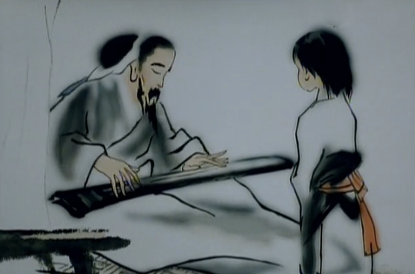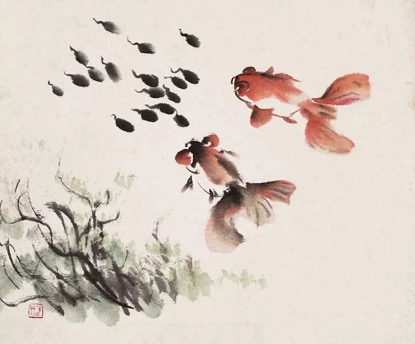In this post, I illustrate how the early Chinese ink painting animation showed oriental aesthetics, conveying implicit and meaningful emotions. It was closely related to the traditional Chinese ink painting and reflected the unique philosophical concept of the Chinese ancients: Tao.
Chinese ink animation, like Chinese ink painting, was good at using a lot of blank, leaving in negative space to create a void and mysterious effect. This method gave the audience enough space to re-imagine the visual elements and their meanings, creating a suspense effect and ethereal illusion. Take, for instance, Feelings from Mountain and Water (1988), which describes a deep relationship between an apprentice and his master. There is no dialogue in the whole short film, and the expressions of the characters are very subtle and delicate, filled with the gentle and restrained atmosphere of water mist. Another example is Where is Mama (1960), which tells a journey of tadpoles looking for their frog mother. Due to the shape of their mother being so different from themselves, the tadpoles frequently identify other creatures as their mothers in the process of searching, resulting in a lot of humor. In these two shorts, animators did not directly use blue paint or lines to show the water-related environment like many western animations and paintings did. They fully used the blank parts of the picture to symbolize water waves, rivers, lakes, clouds, and so on. The characters sometimes float on the screen and sometimes merge into the background, creating a kind of visual effect that is detached. Thus, this brings an erratic psychological feeling to the audience.
This kind of visual effect brought by blank-leaving skills in these animations is deeply influenced by almost all traditional Chinese literati paintings. For example, Zhu Da, a famous literati painter in the Ming Dynasty, was particularly good at using a lot of blank space to manage the picture, so that the audience’s sight is allowed to wander in all corners of the picture.
Moreover, Chinese ink animation is good at blurring the shape of the character with the blending technique by using the traditional Chinese brush and thin rice paper, creating an uncertain but freestyle effect between likeness and differences in terms of the image of characters. For example, in Where Is Mama, the shape of the shrimp is borrowed from Qi Baishi’s ink painting. The body of the shrimp is smudged by two or three vague inks, and then the shrimp whiskers are outlined with minimal lines. Even if the animators omitted a lot of details and blurred the edge of the shrimp body, the audience could still clearly get that it was a shrimp. This is because the animators influenced by traditional Chinese ink paintings pursued the similarity in the spirit, rather than the similarity in the outlook.
Why do these Chinese animators and painters always use blank spaces, omissions, and blur techniques in their works? It is deeply connected to the traditional Tao philosophy.
Tao is a Chinese word signifying “way”, “path”, “route”, “road” or sometimes more loosely “doctrine”, “principle” or “holistic beliefs”. In the context of East Asian philosophy and East Asian religions, Tao is the natural order of the universe. It is like a kind of energy with constantly changing forms, shuttles between all objects in the universe, and establishes the inner spiritual bonds between various creatures and nature in an imperceptible way. Laozi in the Tao Te Ching explains that Tao is not a “name” for a “thing” but the underlying natural order of the universe whose ultimate essence is difficult to circumscribe due to it being non-conceptual yet evident in one’s being of aliveness. The Tao is “eternally nameless” (Tao Te Ching-32. Laozi) and to be distinguished from the countless “named” things which are considered to be its manifestations, the reality of life before its descriptions of it.
In my opinion, Tao is something like a constantly changing energy that is difficult to define and describe. It exists in all things in the universe, and is constantly changing according to a certain natural law that humans cannot fully recognize. In other words, we can perceive the existence of Tao, but we cannot see or understand it rationally and clearly. Based on this, Taoism flourished in ancient China as a native Chinese religion. Its core philosophical concept is doing nothing but respecting the laws of nature in everything. Humans should neither interfere with them nor help them presumptuously, but let nature take its course.
This philosophical concept has deeply influenced traditional Chinese literati and artists. This is why they often use a lot of omission techniques and minimalist line-drawing techniques in writing and painting. Animators and painters have maturely adopted blank-leaving and blurring techniques to organize the image. This is because when everything is reduced to nothing, the reader or viewer can better perceive the existence of Tao from the void created by “nothing”. Due to Taoism, existence is nothingness, and nothingness will reflect existence itself.
Shengwei Zhou is an award-winning animator, director, and screenwriter. He got his bachelor’s and master’s degrees at School of Art, Peking University in Beijing. Now, he continues his MFA study in Animation and Digital Arts program at University of Southern California. His feature animation SHe won over 50 awards and selections in film festivals around the world including 21st Shanghai International Film Festival Best Animation Nomination, 2019 Animation Is Film Festival Official Selection, and 23rd Fantasia International Film Festival Official Selection.





